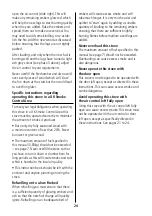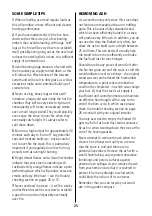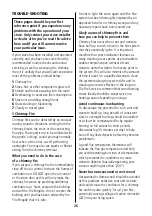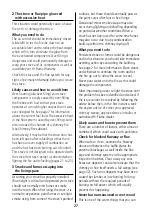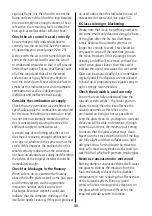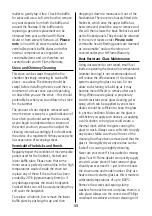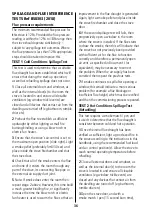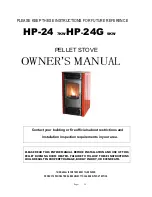
SOME SIMPLE TIPS
1
When refuelling use small regular loads as
this will produce a more efficient and cleaner
burning performance.
2
If you have inadvertently let the fire burn
down so that there are just a few burning
embers then avoid reloading with large ‘cold’
logs as the fire will be very slow to re-establish
itself, possibly even going out as the new load
reduces the existing fire’s access to a sufficient
supply of combustion air.
3
Avoid burning large amounts of wood with
the Secondary air supply turned down as this
will reduce the effectiveness of the Airwash
system and will result in dirty glass, as well as
excessive smoke and a potential build-up of
creosote tars.
4
Never use big, heavy logs as these will
introduce a large cold spot inside the hot fire-
chamber. They will be very slow to light and
consequently will create unnecessary smoke
over a much longer period. They could possibly
even cause the stove to over-fire when they
eventually catch alight. It’s always safer to
split these down.
5
Burn on a high output for approximately 30
minutes each day to ‘burn off’ any potential
soot and creosote build-up – but be careful
not to over-fire the stove. This is particularly
important if you regularly burn low for long
periods such as overnight burning.
6
Bright vibrant flames and a clean firechamber
indicate that your stove is operating well.
Lacklustre dirty orange flames indicate a poor
performing stove which will produce excessive
smoke and very little heat – see the Trouble-
shooting section on pages 26 to 31.
7
Never overload the stove – it will be smoky
and inefficient as well as very slow to establish
a good burn and could possibly eventually
over-fire.
REMOVING ASH
As a wood burning-only stove this stove does
not feature a removable ash pan or riddling
grate. This is because fully seasoned wood,
which has been efficiently burned in a stove,
will produce very little ash. In addition, you do
not need to clear the firebed very often, but
allow the ash to build up to a depth between
25 to 30mm. This ash bed will actually help
the wood to burn more efficiently and make
the fuel load last for much longer.
Should there be any pieces of wood left after
the fire has gone out and the stove is cold this
would indicate one of two things – the original
wood was wet and reduced the firechamber
temperature to a point where combustion
could not be completed – in which case change
your fuel. Or, that the stove’s air supply is
insufficient and cannot promote and maintain
an effective flue draught all the way to the
end of the burn cycle, in which case please
check the trouble-shooting section on page
26 or consult with your original installer.
You only ever need to empty the firebed if it
gets too full of ash and this creates nuisance
fly-ash or when standing down the stove at the
end of the heating season.
Never attempt to remove the ash when the
stove is hot. Always wait until you are sure
that the stove is cold and there are no
potential live embers. Remove the ash with a
small shovel taking care to protect decorative
furnishings and porous surfaces against
potential ash spillage. As you remove the ash
from your home ensure that it is covered to
protect it from any draught or wind which
could blow the ash out of its container.
Remember that you can recycle your wood
ash in the garden compost.
25














